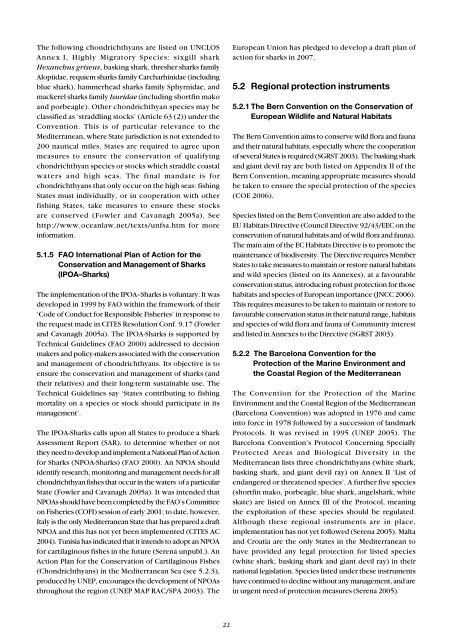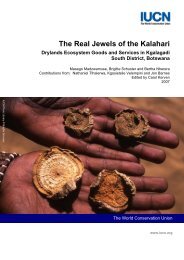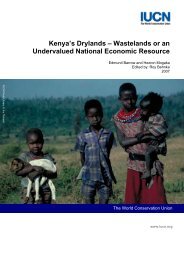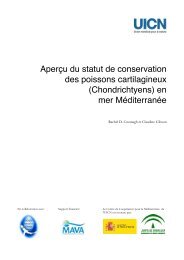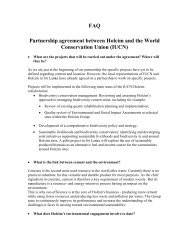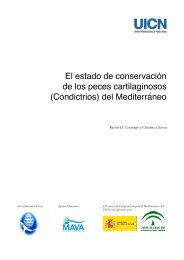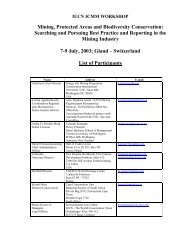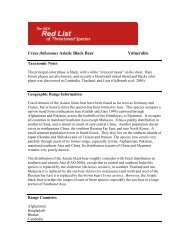iucn mediterranean sharks (pdf) - The Shark Trust
iucn mediterranean sharks (pdf) - The Shark Trust
iucn mediterranean sharks (pdf) - The Shark Trust
You also want an ePaper? Increase the reach of your titles
YUMPU automatically turns print PDFs into web optimized ePapers that Google loves.
<strong>The</strong> following chondrichthyans are listed on UNCLOSAnnex I, Highly Migratory Species: sixgill sharkHexanchus griseus, basking shark, thresher <strong>sharks</strong> familyAlopiidae, requiem <strong>sharks</strong> family Carcharhinidae (includingblue shark), hammerhead <strong>sharks</strong> family Sphyrnidae, andmackerel <strong>sharks</strong> family Isuridae (including shortfin makoand porbeagle). Other chondrichthyan species may beclassified as ‘straddling stocks’ (Article 63 (2)) under theConvention. This is of particular relevance to theMediterranean, where State jurisdiction is not extended to200 nautical miles. States are required to agree uponmeasures to ensure the conservation of qualifyingchondrichthyan species or stocks which straddle coastalwaters and high seas. <strong>The</strong> final mandate is forchondrichthyans that only occur on the high seas: fishingStates must individually, or in cooperation with otherfishing States, take measures to ensure these stocksare conserved (Fowler and Cavanagh 2005a). Seehttp://www.oceanlaw.net/texts/unfsa.htm for moreinformation.5.1.5 FAO International Plan of Action for theConservation and Management of <strong>Shark</strong>s(IPOA–<strong>Shark</strong>s)<strong>The</strong> implementation of the IPOA–<strong>Shark</strong>s is voluntary. It wasdeveloped in 1999 by FAO within the framework of their‘Code of Conduct for Responsible Fisheries’ in response tothe request made in CITES Resolution Conf. 9.17 (Fowlerand Cavanagh 2005a). <strong>The</strong> IPOA-<strong>Shark</strong>s is supported byTechnical Guidelines (FAO 2000) addressed to decisionmakers and policy-makers associated with the conservationand management of chondrichthyans. Its objective is toensure the conservation and management of <strong>sharks</strong> (andtheir relatives) and their long-term sustainable use. <strong>The</strong>Technical Guidelines say ‘States contributing to fishingmortality on a species or stock should participate in itsmanagement’.<strong>The</strong> IPOA-<strong>Shark</strong>s calls upon all States to produce a <strong>Shark</strong>Assessment Report (SAR), to determine whether or notthey need to develop and implement a National Plan of Actionfor <strong>Shark</strong>s (NPOA-<strong>Shark</strong>s) (FAO 2000). An NPOA shouldidentify research, monitoring and management needs for allchondrichthyan fishes that occur in the waters of a particularState (Fowler and Cavanagh 2005a). It was intended thatNPOAs should have been completed by the FAO’s Committeeon Fisheries (COFI) session of early 2001; to date, however,Italy is the only Mediterranean State that has prepared a draftNPOA and this has not yet been implemented (CITES AC2004). Tunisia has indicated that it intends to adopt an NPOAfor cartilaginous fishes in the future (Serena unpubl.). AnAction Plan for the Conservation of Cartilaginous Fishes(Chondrichthyans) in the Mediterranean Sea (see 5.2.3),produced by UNEP, encourages the development of NPOAsthroughout the region (UNEP MAP RAC/SPA 2003). <strong>The</strong>European Union has pledged to develop a draft plan ofaction for <strong>sharks</strong> in 2007.5.2 Regional protection instruments5.2.1 <strong>The</strong> Bern Convention on the Conservation ofEuropean Wildlife and Natural Habitats<strong>The</strong> Bern Convention aims to conserve wild flora and faunaand their natural habitats, especially where the cooperationof several States is required (SGRST 2003). <strong>The</strong> basking sharkand giant devil ray are both listed on Appendix II of theBern Convention, meaning appropriate measures shouldbe taken to ensure the special protection of the species(COE 2006).Species listed on the Bern Convention are also added to theEU Habitats Directive (Council Directive 92/43/EEC on theconservation of natural habitats and of wild flora and fauna).<strong>The</strong> main aim of the EC Habitats Directive is to promote themaintenance of biodiversity. <strong>The</strong> Directive requires MemberStates to take measures to maintain or restore natural habitatsand wild species (listed on its Annexes), at a favourableconservation status, introducing robust protection for thosehabitats and species of European importance (JNCC 2006).This requires measures to be taken to maintain or restore tofavourable conservation status in their natural range, habitatsand species of wild flora and fauna of Community interestand listed in Annexes to the Directive (SGRST 2003).5.2.2 <strong>The</strong> Barcelona Convention for theProtection of the Marine Environment andthe Coastal Region of the Mediterranean<strong>The</strong> Convention for the Protection of the MarineEnvironment and the Coastal Region of the Mediterranean(Barcelona Convention) was adopted in 1976 and cameinto force in 1978 followed by a succession of landmarkProtocols. It was revised in 1995 (UNEP 2005). <strong>The</strong>Barcelona Convention’s Protocol Concerning SpeciallyProtected Areas and Biological Diversity in theMediterranean lists three chondrichthyans (white shark,basking shark, and giant devil ray) on Annex II ‘List ofendangered or threatened species’. A further five species(shortfin mako, porbeagle, blue shark, angelshark, whiteskate) are listed on Annex III of the Protocol, meaningthe exploitation of these species should be regulated.Although these regional instruments are in place,implementation has not yet followed (Serena 2005). Maltaand Croatia are the only States in the Mediterranean tohave provided any legal protection for listed species(white shark, basking shark and giant devil ray) in theirnational legislation. Species listed under these instrumentshave continued to decline without any management, and arein urgent need of protection measures (Serena 2005).22


